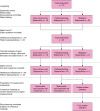The empty pelvis syndrome: a core data set from the PelvEx collaborative
- PMID: 38456677
- PMCID: PMC10921833
- DOI: 10.1093/bjs/znae042
The empty pelvis syndrome: a core data set from the PelvEx collaborative
Erratum in
-
Corrigendum: The empty pelvis syndrome: a core data set from the PelvEx collaborative.Br J Surg. 2024 Mar 2;111(3):znae095. doi: 10.1093/bjs/znae095. Br J Surg. 2024. PMID: 38551120 Free PMC article. No abstract available.
Abstract
Background: Empty pelvis syndrome (EPS) is a significant source of morbidity following pelvic exenteration (PE), but is undefined. EPS outcome reporting and descriptors of radicality of PE are inconsistent; therefore, the best approaches for prevention are unknown. To facilitate future research into EPS, the aim of this study is to define a measurable core outcome set, core descriptor set and written definition for EPS. Consensus on strategies to mitigate EPS was also explored.
Method: Three-stage consensus methodology was used: longlisting with systematic review, healthcare professional event, patient engagement, and Delphi-piloting; shortlisting with two rounds of modified Delphi; and a confirmatory stage using a modified nominal group technique. This included a selection of measurement instruments, and iterative generation of a written EPS definition.
Results: One hundred and three and 119 participants took part in the modified Delphi and consensus meetings, respectively. This encompassed international patient and healthcare professional representation with multidisciplinary input. Seventy statements were longlisted, seven core outcomes (bowel obstruction, enteroperineal fistula, chronic perineal sinus, infected pelvic collection, bowel obstruction, morbidity from reconstruction, re-intervention, and quality of life), and four core descriptors (magnitude of surgery, radiotherapy-induced damage, methods of reconstruction, and changes in volume of pelvic dead space) reached consensus-where applicable, measurement of these outcomes and descriptors was defined. A written definition for EPS was agreed.
Conclusions: EPS is an area of unmet research and clinical need. This study provides an agreed definition and core data set for EPS to facilitate further research.
© The Author(s) 2024. Published by Oxford University Press on behalf of BJS Foundation Ltd.
Figures


References
-
- Johnson YL, West MA, Gould LE, Drami I, Behrenbruch C, Burns EM et al. Empty pelvis syndrome: a systematic review of reconstruction techniques and their associated complications. Colorectal Dis 2022;24:16–26 - PubMed
-
- Barber HRK, Johnson JC. In: Nichols DH (ed.), Gynecologic and Obstetric Surgery. St Louis, MO: Mosby—Year Book, Inc., 1993, 682
-
- Sutton PA, Brown KGM, Ebrahimi N, Solomon MJ, Austin KKS, Lee PJ. Long term surgical complications following pelvic exenteration—operative management of the empty pelvis syndrome. Colorectal Dis 2022;24:1491–1497 - PubMed
-
- Venchiarutti RL, Solomon MJ, Koh CE, Young JM, Steffens D. Pushing the boundaries of pelvic exenteration by maintaining survival at the cost of morbidity. Br J Surg 2019;106:1393–1403 - PubMed
-
- Robertson G, Lopes A, Beynon G, Monaghan JM. Pelvic exenteration: a review of the Gateshead experience 1974–1992. Br J Obstet Gynaecol 1994;101:529–531 - PubMed

